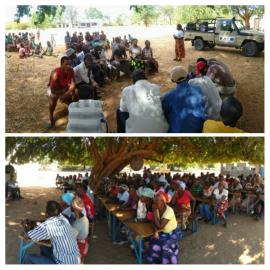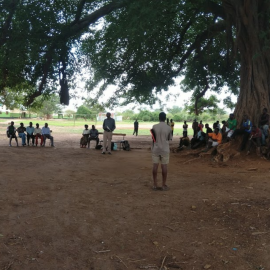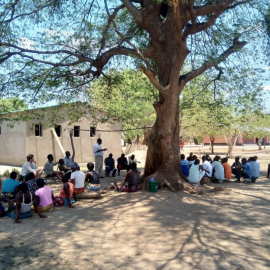Lower Zambezi Fisheries Management Project
Current initiative
Published

Community involvement in transboundary wildlife conservation in the Lower Zambezi/Mana Pools TFCA Project.
The project was implemented by Conservation Lower Zambezi (CLZ) to increase the involvement of fishing communities in conservation activities, particularly to stop cross-border illegal wildlife trade. The development and implementation of a fisheries management plan was designed to serve as incentive for fishing communities to participate in conservation to a greater degree in an area where human-wildlife-conflict is rife and build trust between the communities and conservation organisations.
Lead
Location
Lower/Middle Zambezi, from Kariba Dam wall to the Mozambique border, covering approximately 250km of river.
The poaching and wildlife trade problem
Species affected African Elephant Loxodonta africana , Antelope , Leopard Panthera pardus , Leopard Tortoise Stigmochelys pardalis , Lion Panthera leo , Temminck's Ground Pangolin Smutsia temminckii , Fish
Products in tradeIvory, pelts, live and dead pangolins and tortoises, bushmeat. Fish are also caught out of season or in illegal gears.
Overview of the problem
Bushmeat: Local poachers using wire snares and dogs for small- and medium- sized antelopes near villages, and illegal firearms for buffalo. There is however little poaching of larger species like hippos due to high tourist traffic on the river. Most poaching is for subsistence for food and local sale, but unsustainable rates and methods has lead to virtual elimination of wildlife near settlements.
IWT: This is usually outside actors but with local facilitation who primarily seek high-value products like ivory, pelts and pangolin. For more details on IWT and anti-poaching efforts in the area please see the Wildlife Protection in the Lower Zambezi case study.
The area has a relatively good ‘alternative income’ from a high density of tourism businesses (although still collecting data) leading to some perception of the value of wildlife. High HWC reduces the value of larger, dangerous species like elephant, hippo and crocodile.
The anti-IWT initiative
In this project, the assumption was that cross-border IWT is facilitated by the fishing communities, as they have access to boats to cross the river. To combat this, the communities are involved in both open- (public discussion meetings) as well as closed- (anonymous tip-off hotline, informer incentives) anti-poaching activities.
The open-discussions reflected a high amount of HWC that complicates understanding about what people think about IWT. The hotline approach is yet to be trialled, but informer networks and investigations capabilities are already in existence in the wildlife authorities and supported by other projects.
A prior-informed-consent tour was instigated at the start of the project, and the communities expressed willingness to cooperate with the project. HWC and outdated fishing regulations were their biggest concerns, and will form the entry-point for more detailed discussion on IWT.
The strategy
Strengthening disincentives for illegal behaviour
CLZ already supports community scouts with salaries and equipment. These are managed by the wildlife authority.
The project does provide for performance incentives, as well as paid intelligence. Voluntary actions are expected of fishing committees. Unlike terrestrial wildlife, there is a greater sense of ownership of the fishing resource by the fishing communities.
Increasing incentives for wildlife stewardship
We are addressing regulation changes in fishing that should benefit both fishers and the fish. The area already sees a good flow of benefits from tourism, fishing and hunting tourism through employment, as well as leasing (concession fees), 50% of which are due to the community (through Community Resource Boards (CRBs)). Unfortunately, the community component is often paid late (up to a year), and this is a problem with all CRBs across the country, which is harming the CBNRM model in Zambia, and alienating communities from their wildlife as the benefits are delayed to such a degree.
People continue their subsistence resource use for most resources without much impediment, except in the stricter classes of protected areas like National Parks.
Decreasing the costs of living with wildlife
This project has little provision for taking action on HWC, beyond understanding its link to people’s perceptions of wildlife and incentive for facilitation of IWT. There is some provision to use project equipment (boat, vehicle) to respond to HWC emergencies to improve the response-time after incidents (one of the most widely expressed complaints).
Increasing livelihoods that are not related to wildlife
Whilst fish are technically considered wildlife, in this case helping conserve and manage the fish stock should secure the fishing resource as the already-viable ‘alternative’ it provides to poaching.
The community-level benefits such as infrastructure is theoretically what the CRBs are supposed to spend their CBNRM share on, after consulting with the various sub-committees (village action groups or VAGs) who are supposed to identify priority projects. In practice, delayed receipt of funds and lack of transparency mean that the link to wildlife is still under appreciated.
Build/and or support sense of community ownership or stewardship
Further detailThis is widespread, particularly of the fish stocks. In wildlife, we also endeavour to explain to theoretical linkage between wildlife utilisation (through tourism and hunting), and the devolved benefits explained above.
By being consulted on fishing issues, and giving input to management recommendations, the communities should feel a strengthened sense of ownership and official recognition from conservation organisations and government partners that that ownership is recognised.
Improving education and awareness
Further detailCLZ has a very successful schools programme in environmental education.
This project also has an education and awareness component, again particularly in fisheries, where conflicts between fishing stakeholders (local artisanal fishers vs tourist angling) are mitigated through increased flow of knowledge between the two sectors. A lot of misunderstanding of each-other’s activities exists between the two sectors, and by researching the dynamics of each, the project is a good arbitrator. Results are communicated through public meetings and through elected fishing representatives for the artisanal fishery, and social media and an email update group for the tourism stakeholders.
Has the initiative made a difference?
Too early to tell, but stakeholders from all sides (including government) have expressed satisfaction with progress, and confidence in the project.
What works and why
What really works well in this project is the use of recognised community communication channels. Holding ‘sensitisation meetings’/public meetings, organised through the traditional leadership (headmen and -women), is a very cost-effective way of communicating to a large audience. The meetings are interactive, with ample opportunity for questions and answers. In communities with low literacy rates, more common communication strategies such as flyers, radio broadcasts, etc. often have an unsatisfactory reach.
Wherever conservation organisations work near communities, it would be worthwhile investing in the employment of local community facilitators, and play a monitoring and support role in CBNRM activities to encourage and support meetings and transparency.
Factors for success
Supportive national policy/legislation on sustainable use of natural resources
Devolved decision-making power so local communities have a voice in creating or co-creating solutions (as part of the initiative)
Effective and trusted community leaders
Zambia has excellent CBNRM legislation in its wildlife, fisheries and forestry Acts. There is also recognition that CBNRM needs to be streamlined between the three laws. The devolution of funding and decision making has, however, not yet been fully achieved in practice.
National legislation ‘nationalises’ community user rights to a large degree, and reintroducing concepts like ‘territorial user rights for fisheries’ (TURF) bylaws should help compliment traditional management structures.
What doesn’t work and why
Prospective donors would do well to understand the ‘on-the-ground’ realities and come up with innovative projects in consultation with local field experts. Many large-scale donor projects merely ‘recycle’ the same approaches and address the same issues. In countries with a lot of donor support, both government officials and community leaders learn ‘catchphrases’ that gained support previously and use them when consulted on what the needs are. This can result in donor interventions taking a tangent that can get quite far away from the realities on the ground!
Factors that limited or hindered success
Lack of long-term donor support that is flexible, adaptive and/or based on realistic time goals
Insufficient time investment in building relationships and trust between the initiative and local communities
Ineffective and unaccountable community-based natural resources management institutions
Lack of transparent and accountable distribution of benefits to local communities
The current project falls somewhat short on flexibility of funding and timelines, and underestimates the amount of time needed to gain community trust and buy-in. There certainly are not the funds and time to meaningfully restructure and assist CBNRM structures, but this could form part of a longer-term vision that other donors could support.
Organisers, donors and partners
This project sits under the EU-funded ‘Partnership for improved anti-poaching and compatible land use in community lands of Lower Zambezi-Mana Pools Transboundary Conservation Area project’ Implementing partners are African Wildlife Foundation (AWF) and Conservation Lower Zambezi (CLZ).
European Union
African Wildlife Foundation- Zimbabwe
Conservation Lower Zambezi- Zambia
Harvest Help Zambia (local NGO)- Zambia
Department of Fisheries- (DoF)- Zambia
Department of National Parks and Wildlife (DNPW)- Zambia
Department of National Parks and Wildlife Management (Zimparks)-Zimbabwe
Private-sector contributions- funding and in-kind, to both CLZ and directly to the project.
For further information contact Carl Huchzermeyer (carl@conservationlowerzambezi.org).



